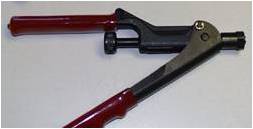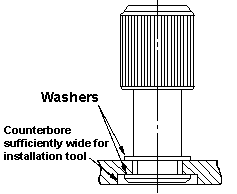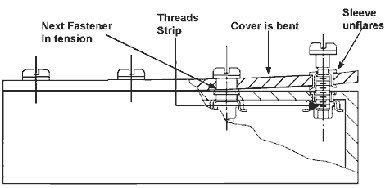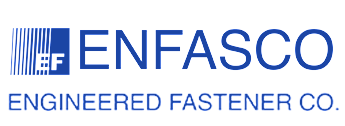
Request A Quote
Howmet Fastening Systems
Enfasco is the largest stocking distributor of Howmet Panel fasteners including captive screws and rivetless nutplates. Howmet, formerly Howmet and Deutsch Fastener offers a wide variety of Captive Fasteners and rivetless nut plates. These fasteners have been integral components in thousands of products made by virtually every major airframe and electronics manufacturer world wide.
Whether Specified for use in Aerospace, electronics, transportation or industrial products, theese fasteners have served industry for more than 50 years. With their flared sleeve design, Howmet's captive fasteners are engineered for strength, reliability and perminance.
The advantage of using captive fasteners and rivetless nutplates include the prevention of loss, reduced inventory and improved speed of assembly. They also enhance product safety by reducing the potiential for loose hardware in moving parts.
Inventory Search »
Related Information
Installation Procedures
Troubleshooting Installations

Captive Screw (Tucson) Drawings
D( )747-( ) Flat Washer, Floating Application
D( )7500 Turn-loc, Low Profile, Optional Recess
D7118-( )–( ) Wave Shaped Spring Washer, All sizes
DRB7500 Turn-Loc, High Profile, Optional Recess
DRBWW( )7500 Turn-Loc, Self-Locking, All Sizes, Optional Recess
DRS( )7500 Turn-Loc, High Profile, Optional Recess, All Cres
DRSS( )7500 Turn-Loc, High Profile, Optional Recess, Optional size
F( )7500 Turn-Loc, Low Profile, Optional Recesses, .031 Radial Float
FRB7500 Turn-Loc, Hugh Profile, Optional recess, .031 Radial Float
FRBWW( )7500 Turn-Loc, Locking, High Profile, Optional Recess, .031 Radial Float
FRS( )7500 Turn-Loc, High Profile, Optional Recess, .031 Radial Float, Cres
FRSS7500 Turn-Loc, High Profile, Alum Knob, Optional Recess, .031 Radial Float
FRBHCWW(3)7500 Turn-Loc, All sizes, locking, .031 Radial Float, All Cres
FRWS7500 Turn-Loc, Retractable, Optional Size, .031 Radial Float Locking
6010 Rivetless Nutplates

Panel 7900 Series
DCT7900 Captive Screw Fasteners, Optional Head, Fixed Thread Length
DCTL( )7900 Captive Screw Fasteners, Optional Recess, Locking, Controlled Thread Length, All Cres
DKN7900 Captive Screw Fasteners, Knurled Pan Head, All Sizes
DLMC7900 Captive Screw Fasteners, size 10 & 12, 100 ° Flush Head
DPY( )( )7900 Captive Screw Fasteners, 100° Flat Head, Optional Recess, Controlled Thread Length
DPY(S/G)( )7900 Captive Screw Fasteners, Flush Head, Optional Recess, Fixed Thread Length
DS( )( )7900 Captive Screw Fasteners, Optional Recess, Spring Loaded, Fully Retractable, All Cres
FS( )( )7900 Captive Screw Fasteners, Optional Recess, Spring Loaded, Fully Retractable, All Cres
FDC( )7900 Captive Fasteners, Internal Floating, Pan Head, Slot Or Cross Recess, Fixed Length
FKN( )7900 Captive Fasteners, Internal Floating, Standard Sizes
( )LW7900( ) Captive Screw, Internal float, High Profile, Spring Loaded, Fixed Thread Length
Captive Screws Press-In & Nut Retainer Types
CFB( )7950 Captive Screw, Snap-in, Floating, Spring Loaded, Cross Recess, Lipped Sleeve
D( )( )7950 Captive Screw, Snap-In, Optional Size, Optional Head, Optional Recess
D( )7910 Captive Screw, Retainer Held, fillister Head, Optional Recess, All Sizes
D( )7920 Captive Screw, Spring Loaded, Removable, Optional Head
HJ( )( )7940 Captive Jacking Screw, Optional Recess

Installation Tool Series
Multi 8603 Universal Hand Installation Tool For Captive Screws & Turn-Loc Fasteners
Howmet Captive fasteners and rivetless nut plates use the swage (flat collar Figure 1) or flared (100º or 82º countersink figure 2) method of upsetting the sleeve to captivate the assembly to the panel.
Figure 1
Figure 2
There are three types of holes suitable for captive fasteners and Rivetless Nut Plates installation.
Type one: Through-hole
This type of hole is suitable where there is a gap or gasket between top and bottom panels or when flush mating of panels is not required.
Type two: Counter-bore hole
Counter-bore holes maximizes holding power and provides flush mating between top and bottom panels.

Type Three: Counter-sink hole
Countersink-holes are suitable where panel thickness permits. Provides flush matting between bottom and top panels.
Note: See engineering standards page for recommended hole diameters and counter-bore/counter-sink depth and installation tools.
Troubleshooting Installations »
Misalignment:
In situations where more than one captive screw is used to secure a panel, misalignment could occur when the screw does not line up exactly with its mating hole. This is particularly common if the top and bottom panels are produced by different manufacturers. To eliminate this problem, a "radial float" may be built into the captive fastener assembly. In the case of screws, on oversize hole is drilled and washers placed on each side of the panel. (See Figure 1) The maximum available total float in a standard installation is 0.060 inch. Misalignment may also be corrected by installing a floating nut plate. Howmet offers a floating nut plate which is simply installed by flaring and requires no rivets. (Rivetless Nut Plates) The nut element is replaceable, if needed, without removing the entire assembly.

Total Float:
Many definitions can describe the amount of float available in a captive screw or captive nut assembly. "Total Float" refers to the minimum displacement of the shank/nut as it moves diametrically within the hole. In the case of the Howmet captive screws, the maximum float is 0.060 inch. The Howmet rivetless floating nut plate (FF6010) is fixed at 0.060 inch.
Fast Lead Threads:
The advantage of the fast lead threads is in their clamp down speed, which is the speed of the axial travel of the screw per revolution. Fast lead threads considerably reduce the time it takes to remove or secure a panel to its mating part. However because of the increasing angle of the fast lead helix, these threads are prone to loosening under vibration. It is recommended that some method of locking such as a locking nut plate, be used in conjunction with these threads.
Jack-out Damage:
In situations where several captive screws are used to secure a panel, removal may precipitate damaging jack-out loads. These loads develop when a screw reaches the limit of retention permitted by its sleeve, before its threads are completely disengaged from the mating threads of the bottom panel. This can cause damage to threads, the captive screw sleeve and/or the panels themselves.

A simple solution is to specify a captive screw that permits full retraction of the threads within its sleeve. A spring-loaded assembly such as DRB7500 Turn-Loc series or an assembly with a controlled thread length will eliminate or significantly reduce jack-out force.
Corrosion:
Corrosion , the wearing away or oxidation of a metal, may be caused either by galvanic electrochemical reaction or by direct chemical attack. An example of galvanic corrosion is the oxidation of aluminum plates secured by steel screws in a humid environment. Galvanic attack may be avoided by selecting the same or similar metals in a mating assembly. When dissimilar metals are used, separate them with a dielectric material interface such as insulation or inert compounds. Plating, or other surface coatings, may also be specified.
Vibration:
A captive screw assembly used in an area of vibration may loosen and, in extreme cases, may disengage from its mating part. This can be avoided by using a locking device such as a lock washer or self-locking nut plate. Some captive fasteners, such as the Howmet ZL, are designed to reduce loosening due to vibration.
© Enfasco Inc. t/a Engineered Fastener Co. 1978 -
